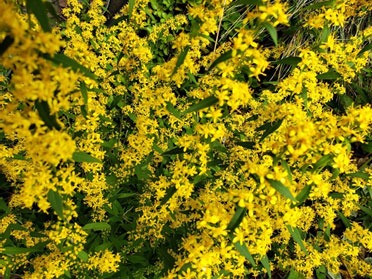Unlike many unfortunately-named native plants such as milkweed, sneezeweed, and ironweed, goldenrod has a name that conjures an image of fairies in a field tapping their magic wands. The name seems appropriate because this perennial provides food for the more than 180 species of caterpillars in North America and supports many varieties of native bees who would not survive without it. Goldenrod is especially important in the fall when it provides food for insects at a time when fewer flowers are in bloom.
This perennial, whose scientific name is Solidago, covers itself in sprays of tiny yellow flowers that put on quite a beautiful show in the garden. Some plants start blooming in late August, while most bloom from September into October.
This plant, which grows two-to-four-feet tall, can be found in several locations throughout Laurelwood, including the Sensory Garden and Pollinator Garden, an apt location given its value in supporting our insects.
Canada goldenrod (Solidago canadensis) is commonly grown but is an aggressive spreader and probably not a good choice for most gardens, as it will require more of an effort to keep it in check. However, there other better-behaved goldenrods for gardeners. Three choices that are known for getting along with their plant neighbors without crowding them out are licorice-leaved goldenrod (Solidago odora), gray goldenrod (Solidago nemoralis) and early goldenrod (Solidago juncea).
There are at least 27 species of goldenrods in the northeast, so there is one out there that will help meet your needs. Although most prefer full sun, there are species that grow in a variety of conditions from meadows to woodlands. For example, zigzag goldenrod (Solidago flexicaulis) is very drought tolerant.
Another that grows in dry conditions is seaside goldenrod (Solidago serpervirens), which is also salt tolerant. Wreath goldenrod (Solidago caesia), also called blue-stemmed goldenrod, tolerates dry, shady conditions.
One myth you might have heard is that goldenrod affects people with seasonal allergies. This is not true; ragweed is the culprit here, blooming at the same time as goldenrod. Goldenrod is edible and has long been used as a remedy for such ailments as arthritis and eczema. It is said to reduce pain and inflammation. In nature, goldenrod is often found growing with asters, but it also combines well with orange milkweed and bunching grasses, such as little bluestem.
Many gardeners are aware of the lifecycle of the beautiful monarch butterfly, a “snowbird” who travels thousands of miles from the northeast to mountains in central Mexico where it spends the winter. Goldenrods are vital to our monarchs who migrate in the fall and feed on its nectar when little else is in bloom. It also provides seeds for many birds.
As you consider which new plants to add to your garden, be sure to consider goldenrod. It will make your garden more eco-friendly by supporting our pollinators and birds!


